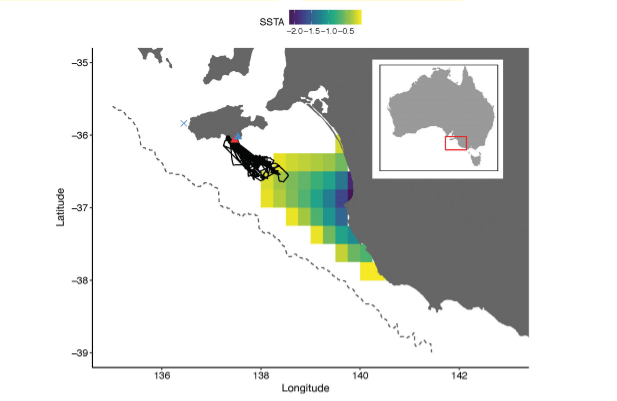The Influence of Oceanographic Conditions on Foraging Strategies in Long-nosed Fur Seals.
The long-nosed fur seal, Arctocephalus forsteri, is a species of fur seal that is found mainly around southern Australia and New Zealand. They experienced a large amount of over-harvesting between 1801 and 1830. This resulted in a significant reduction in their numbers, to the point that they were on the brink of extinction for 150 years. After receiving protection status by the Australian Government, their numbers have since been able to increase and astonishingly they are now one of the most abundant species of fur seals in Australia.
The majority of the long-nosed fur seal’s breeding colonies are concentrated within the Great Australian Bight ecosystem. This is a large open bay off the southern coastline of mainland Australia. Here, the main colony of long-nosed fur seal is located at Cape Gantheaume, which is a headland located at the south coast of Kangaroo Island. The colony occupying this region is in close proximity to the Booney Upwelling. The Booney Upwelling is a large seasonal coastal upwelling which brings in cold nutrient rich water to the sea surface, from November to April. Upwellings are known for supporting regionally high productivity and species diversity, and the Booney Upwelling is no exception.
The Subtropical Front is another important habitat for the long-nosed fur seals. This is a biogeographical region which separates the warm subtropical waters of the north from the cooler sub-Antarctic waters of the south. This region is also characterised by high productivity, which makes it an ideal foraging ground for marine mammals.
During the upwelling season, long-nosed fur seals make short, 5-day trips to the shelf waters which is associated with the Booney Upwelling waters. In contrast, during the non-upwelling months, individuals make longer, 2-week trips to the oceanic waters associated with the Subtropical Front, until their pups have been weaned.
Under the Marginal Value Theorem, it can be predicted that individuals will make longer trips to oceanic regions due to a reduced prey availability in the shelf waters. The change in foraging location, from the shelf to oceanic regions, is believed to be caused by a decline in upwelling in the shelf regions. However, there is also evidence that the timing of the switch of locations is variable between individuals. This suggests that there are some intrinsic factors, such as age/size or reproductive success, that is influencing the switch.Video of Long-nosed fur seal at Kangaroo Island, Australia
A study by Foo et al., (2019) investigated the environmental and intrinsic factors that are associated with the transition of lactating long-nosed fur seals from the upwelling shelf regions to the oceanic regions. In this study, 45 long-nosed fur seals were tagged and tracked using Geolocation loggers for the years 2016 and 2017. These loggers measured ambient light in regular intervals, which was used to estimate the location of the individuals.
The results of the study showed that lactating long-nosed fur seals transitioned from shelf to oceanic foraging as the pup rearing progressed. Indeed, this switch was associated with a weakening of the Booney Upwelling on the shelf. As food availability decreases, females changed their foraging location in order to meet the energetic demands of rearing their pup. In 2016 when the strength of upwelling was greatest, the timing of the switch from shelf to oceanic regions was less variable between individuals. In contrast, in 2017, the upwelling was relatively weak in the shelf region. This meant that some individuals may have made the switch from shelf to oceanic regions earlier to compensate for the food shortage in the shelf upwelling region.
It may be expected that reproductive success would have been higher in 2016 due to a higher food abundance, thus enabling greater food provision to the pups. However, this was not the case. The pups in 2017 were significantly larger than those in 2016. One possible explanation is that individuals in 2017 had to respond to food shortages by making longer foraging trips and increasing their foraging efforts. It has been shown that these more intensive foraging trips resulted in greater food delivery to the pup. In addition, there was greater diversity in foraging strategies between the 2017 females. As a result of the food shortage in the upwelling regions, some females moved to the oceanic regions earlier than would usually be expected. It is possible that the disparity in foraging locations would reduce competition between individuals, thus allowing a greater foraging success and healthier pups.
This study showed how seasonal oceanographic conditions can have significant influences on the foraging strategies deployed by long-nosed fur seals, which can in turn have an effect on the reproductive success of individuals. It is important to consider how future extreme environmental events caused by climate change may not only affect the long-nosed fur seals, but marine mammals in general.
Reference:
Foo, D., Hindell, M., McMahon, C. et al. Environmental drivers of oceanic foraging site fidelity in central place foragers. Mar Biol 167, 76 (2020). https://doi.org/10.1007/s00227-020-03685-y
SHARE THIS ARTICLE















